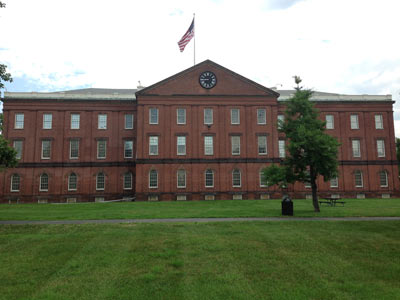Beginning in 1777, the Springfield Arsenal stored new munitions as well as captured weapons. It opened as a manufacturing Armory in 1794. The museum was formalized in 1871 as a firearm ‘reference library’ for weapon designers at its armory. Today, the collection includes samples made at the Armory, captured weapons from every US war up to WWII, and weapons designed by both domestic and foreign competitors, acquired or donated for study purposes. The Museum’s displays are organized into three areas. The Industry Gallery gives the manufacturing and contextual history of the Arsenal, the Weapons Gallery displays weapons arranged in fifty cases and the Special Exhibits Gallery shows rotating exhibitions. The Weapons Gallery is the largest of the three areas. Its central display is the ‘Organ of Muskets’ a bronze storage unit holding 1,000 M1861 muskets. After an introduction to firearm evolution, the cases are generally arranged by wars and specific arms developed at the Armory. It has low numbered examples of classic firearms, and includes displays of the Springfield Model 1816, M1855, Erskine Allin’s M1873 Trapdoor, M1903 Springfield, M1 Garand, M14, and the M60 machine gun, aka “The Pig”. An excellent selection of both Allied and Axis weapons of the 20th century are shown, including a glass-walled display of twelve static machineguns. A unique strength of the collection are the many prototypes made of the weapons designed at the Armory, as well as cutaway ‘skeletonized’ weapons used for explaining their operation. While not open to the general public, the Springfield Armory has an unparalleled collection of military small arms and prototypes in storage. It also includes cartridges and displays as well as the tools and gages used in munition manufacturing. The 1980’s galleries are in need of a curatorial and infrastructural redesign: the cases are neon lit with inflexible fittings, which discourage changes. MacKenzie, Alex, Springfield Armory, Charleston, (2015)
https://www.youtube.com/watch?v=mRIZuGs2AvA
https://www.youtube.com/watch?v=LTrgGcnRWmo
http://www.nps.gov/spar/planyourvisit/hours.htm
Visit the Springfield Armory Cyber Museum on line at http://ww3.rediscov.com/spring/spring.htm


 1. West Point Museum
1. West Point Museum 2. Springfield Armory
2. Springfield Armory 3. Smithsonian Museum
3. Smithsonian Museum 4. Nunnemacher Milwaukee
4. Nunnemacher Milwaukee 5. Wadsworth Atheneum
5. Wadsworth Atheneum 6. Rock Island Arsenal
6. Rock Island Arsenal 7. Metropolitan Museum NY
7. Metropolitan Museum NY 8. National World War I
8. National World War I 9. FBI Reference Collection
9. FBI Reference Collection 10. NRA National Firearms
10. NRA National Firearms 11. Connecticut History
11. Connecticut History 12. Remington Firearms
12. Remington Firearms 13. Davis Arms Museum
13. Davis Arms Museum 14. National Cowboy Mus.
14. National Cowboy Mus. 15. American Precision
15. American Precision 16. Collectors Firearms
16. Collectors Firearms 17. KY Military History
17. KY Military History 18. Cody Firearms Museum
18. Cody Firearms Museum 19. Woolaroc Museum
19. Woolaroc Museum 20. Kienbusch Philadelphia
20. Kienbusch Philadelphia 21. John Browning Museum
21. John Browning Museum 22. Art Institute Chicago
22. Art Institute Chicago 23. Henry Stewart VMI
23. Henry Stewart VMI 24. Autry Museum
24. Autry Museum 25. Wood Museum S&W
25. Wood Museum S&W 26. National WWII Museum
26. National WWII Museum 27. Frazier History Museum
27. Frazier History Museum 28. Pennsylvania Longrifle
28. Pennsylvania Longrifle 29. Frank Brownell Museum
29. Frank Brownell Museum 30. Inst. Mil. Technology
30. Inst. Mil. Technology 31. NRA Bass Pro Sporting
31. NRA Bass Pro Sporting 32. U S Army Museum
32. U S Army Museum